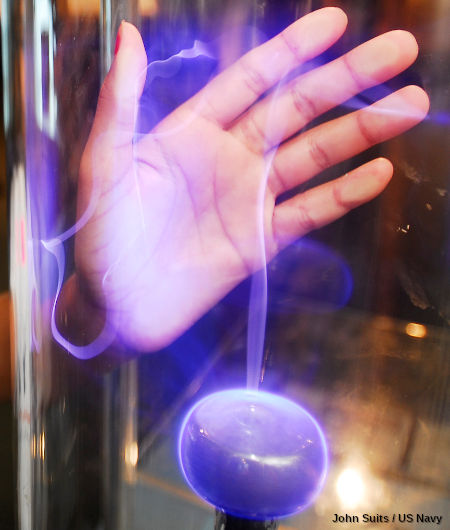What is plasma anyway?

In schools they teach us that all substances come in three basic flavors or states of matter: solid, liquid, and gas. But they're wrong! There's a fourth flavor called plasma (and, arguably, there are even more states of matter too that we won't get into here). What exactly is a plasma and how does it relate to solids, liquids, and gases?
Suppose you have a lump of freezing cold ice (a solid). Heat it up a bit and you'll get a liquid (water). Heat it up a bit more and, pretty soon, you'll have a gas (steam). The more heat you supply, the more energy you inject. The more energetically the molecules (oratoms) have, the further apart they can push and the more they move about. In a solid like water, the molecules are bound tightly together; in liquid water, the molecules are free to move past one another (that's why water can pour and flow); in steam (gaseous water), the molecules are completely free of one another and have so much energy that they spread out to fill all the space available.
But what happens if you don't stop there? What if you keep on heating a gas? The molecules and atoms inside it break apart, releasing some of their electrons so they move freely in and around it. When atoms disintegrate like this, they form positively charged particles called ions. The mixture of positively charged ions and negatively charged electrons in a plasma turns it into a kind of hot soup that will conduct electricity very easily. That's what we mean by a plasma. It's a special type of gas in which some of the atoms have become ions (an ionized gas, in other words).
How a plasma TV set makes its picture
If you've read our articles on energy-saving fluorescent lamps (also known as CFLs) and neon lamps (the lamps that make brightly colored displays in our streets), you'll know how they make light by buzzing electricity through a gas. Imagine if you built a TV screen out of millions of microscopically tiny CFLs or neon lamps, each of which could be switched on or off very quickly, as necessary, by an electronic circuit, to control all the separate pixels (lit-up, colored squares) on the screen. That's pretty much how a plasma TV works and it's very different to other kinds of television technology: in a conventional (cathode-ray) television, the picture is built up by scanning an electron beam back and forth over a screen treated with chemicals called phosphors; in an LCD TV (liquid-crystal display television), polarizing crystals make light rays bend to switch the pixels on and off.
The pixel cells in a plasma TV have things in common with both neon lamps and CFLs. Like a neon lamp, each cell is filled with tiny amounts of neon or xenon gas. Like a CFL, each cell is coated inside with phosphor chemicals. In a CFL, the phosphor is the chalky white coating on the inside of the glass tube and it works like a filter. When electricity flows into the tube, gas atoms crash about inside it and generate invisible ultraviolet light. The white phosphor coating turns this invisible light into visible white light. In a plasma TV, the cells are a bit like tiny CFLs only coated with phosphors that are red, blue, or green. Their job is to take the invisible ultraviolet light produced by the neon or xenon gas in the cell and turn it into red, blue, or green light we can actually see.
- Much like the picture in an LCD screen, the picture made by a plasma TV is made from an array (grid) of red, green and blue pixels (microscopic dots or squares).
- Each pixel can be switched on or off individually by a grid of horizontally and vertically mounted electrodes (shown as yellow lines).
- Suppose we want to activate one of the red pixels (shown hugely magnified in the light gray pullout circle on the right).
- The two electrodes leading to the pixel cell put a high voltage across it, causing it to ionize and emit ultraviolet light (shown here as a turquoise cross, though it would be invisible in the TV itself).
- The ultraviolet light shines through the red phosphor coating on the inside of the pixel cell.
- The phosphor coating converts the invisible ultraviolet into visible red light, making the pixel light up as a single red square.
Good blog post. But do improve your writing and editing skill. Some of the information are not well published. Tq.
ReplyDelete